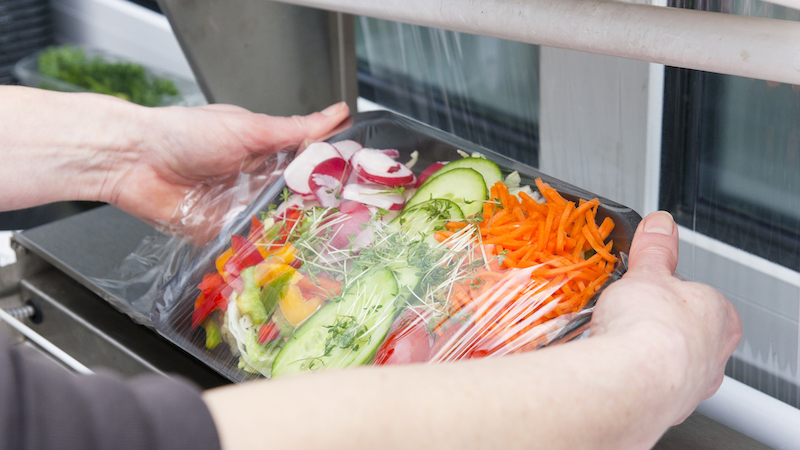Welcome to the first in our blog series taking a closer look at recently released requirements of the Food & Drug Administration’s (FDA) Food Traceability Final Rule, Section 204 of the Food Safety Modernization Act.
Updates to FSMA 204 apply to stakeholders all across the food supply chain and affect their responsibilities for tracking and reporting data related to supply chain events in a way that clearly links to data elements, events, and food products involved.
FSMA 204 is intended to allow potentially contaminated food to be identified and removed from the food supply with far greater speed and precision in the interest of saving lives.
Along with helping to improve response to foodborne illness outbreaks, food supply chain stakeholders from growers to grocers face new opportunities to reduce waste, improve efficiencies, and make data-informed business decisions using information they’re required to capture for compliance.
Our video with Zebra Technologies provides a nice summary!
FSMA 204 is now in fact a law as of November 2022. However, because of the level of cooperation and coordination needed between trading partners, the FDA’s compliance date for the rule is January 20, 2026.
That may feel like a long way off today, but there are plenty of reasons to get started right away on your plan for FSMA 204 compliance. Fortunately, leading brands in the quick-serve restaurant (QSR) space have already been applying data capture and automation solutions well in advance of requirements—and discovering benefits that go well beyond food safety regulatory compliance.
FSMA 204: CTEs, KDEs, and TLCs for FTL Foods
While exemptions apply, parties subject to FSMA 204 are required to establish and maintain a traceability plan for foods on the FDA’s Food Traceability List, and to maintain records of Key Data Elements (KDEs) associated with Critical Tracking Events (CTEs). They’re also required to provide the data electronically to the FDA within 24 hours (or a reasonable, agreed-upon time frame), should the agency contact them.
Because who doesn’t love acronyms, let’s review the essential elements of FSMA 204:
- FTL – Food Traceability List: A peer-reviewed, data-driven list of foods most susceptible to foodborne illness outbreaks. Many of the foods on the list are served fresh at restaurants
- TLC – Traceability Lot Code: A typically alphanumeric, unique code used to identify and trace a product lot within the stakeholder’s records. The TLC is the critical link to tracing a product back to its origin before entering the supply chain
- CTE – Critical Tracking Event: An event in the supply chain involving the harvesting, cooling, packing, receiving (including first receiver), transforming, creating, shipping, or holding of the food, each of which precipitates a requirement to record KDEs
- KDE – Key Data Element: Data elements vary by food and CTE, but KDEs include the commodity or food name/product description, quantity/unit of measure, date/time, TLC, location, and other important information
While a vertically integrated (farm-to-fork) restaurant business could have exposure to all CTEs, most QSRs and grocers rely on supplier partners for their inventories. That means products they receive will have had a TLC assigned by its primary producer (or first land-based receiver for fish or shellfish) at the least.
Products that were processed got new TLCs, but suppliers’ compliance with the rule creates a strong recordkeeping chain that streamlines the tracing of a product all the way back to its source by linking any new TLC to the TLCs of its constituent ingredients—as in a salad including lettuce, cucumber, and tomatoes, for example.
The rule considers restaurants a type of retail food establishment and therefore subject to FSMA 204 rules. CTEs affecting a QSR or grocery store typically only include receipt of shipments. Transformation KDEs don’t apply to food retailers and restaurants for foods that aren’t shipped. But in cases where a central kitchen transforms and ships food (like pre-packaged sandwiches or salads) to retail locations where the products are sold for consumption, that central kitchen functions as a manufacturer/processor.
Data Capture Technologies and GS1 Standards Are FSMA 204-Ready
Fortunately for the rest of us, GS1 Standards are long-established, recently updated, and already facilitating stakeholder collaboration in grocery and foodservice. When trade partners choose to comply with GS1 Standards, they use a common business language for the data they need to capture and share, correlating with the who, what, when, where, and why of a food product’s journey from farm to fork:
- Who – GLN, Global Location Number
- What – GTIN, Global Trade Item Number and SSCC, Serial Shipping Container Code
- When – Recorded dates and times of KDEs
- Where – Read points and business locations (such as wholesaler and retailer locations)
- Why – Business step/event descriptions such as in transit, packing, unpacking, receiving
With the emergence of new GS1 Tag Data Standards (TDS 2.0), extended data like batch and lot information, expiration dates, and more—provide the real estate needed for traceability lot codes. Additionally, GS1 SSCCs enable aggregation of individual items into pallets. GS1 Electronic Product Code Information Services (EPCIS 2.0) provides a global, open standard for data sharing.
Trading partners that choose to record TLCs, CTEs, and KDEs using GS1 data sharing standard EPCIS 2.0 get the benefit of interoperable data to track and trace products, who controls them, and their status, location, and movements.
GTIN and SSCC data can be encoded into GS1-128, GS1 DataMatrix, GS1 QR code barcode configurations, as well as Electronic Product Code-enabled RAIN RFID tags and labels. That means the infrastructure businesses need is ready, and they can easily integrate data capture technologies into their FSMA 204 compliance initiatives.
Added Operational Benefits Ride Along
While FSMA 204 requires that stakeholders supply electronic records of CTEs within 24 hours of being contacted, it does not require the use of specific data capture technologies or solutions to generate the records. That said, the case for RFID tags for inventory has been proven at retail in apparel, and QSRs are already benefiting from improved visibility into:
- Shipment verification at receiving
- Inventory management, including first-in-first-out for optimal freshness
- Streamlined product ordering
- Data-informed production planning
- Asset management (such as reusable transport items)
- Waste tracking
QSRs and grocery operators can put their data to work improving efficiency, reducing waste, optimizing partner relationships, and moving toward sustainability goals, all while ensuring FSMA 204 compliance.
If that all sounds complex, that’s because it is. That’s why it’s important to start with a trusted solution provider with in-house GS1 experience, expertise in labeling, AIDC and IoT, software integration and data analytics. Learn more about the ways RAIN RFID helps improve accuracy, efficiency, and the ability to share information with partners and customers. Click here or below to download the infographic, and look forward to future articles exploring FSMA 204 compliance for other supply chain stakeholders, including growers and processors.







